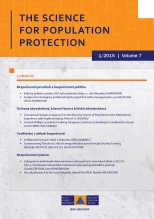PERSONAL PROTECTIVE EQUIPMENT (PPE) IN CBRN INCIDENTS
DOI:
https://doi.org/10.71934/Keywords:
Personal Protective Equipment, CBRN incidents, emergencies, protection, contaminationAbstract
The information referred to in this article was used when teaching the course
"Specialized Training Session Sixth for the Prevention of Weapons of Mass Destruction for
Civil Defence Officers Gulf Cooperation Council for the Arab Gulf States“, which was held in
Kuwait from 30th November to 12th December 2014.
The Cooperation Council for the Arab States of the Gulf invited ‘NATO's Civil
Protection Group’ to provide a training course for the staff of Civil Protection focused on
protection against weapons of mass destruction. The training took place at the training center
of the Ministry of Interior in Kuwait with the participation of representatives of the four Gulf
States: Kuwait, Saudi Arabia, United Arab Emirates, and Bahrain. Officers from various
authorities including the National Guard, Army, Police, Customs Department, Fire
Department, and Medical Emergency took part in the training. The course consisted of
practical and theoretical sessions and was presented by experts of the training team of the civil
protection group of NATO in cooperation with the Fire Department and the Hazardous
Materials Center. It aimed to train the officers and improve their skills in civil protection so
they would be able to deal with weapons of mass destruction and other dangerous materials
and get rid of its effects.1)
Lessons were based on the "Guidelines for First Responders to a CBRN Incident”
developed by the ‘NATO’s Civil Protection Group’, whose member is also the author of this
article. The article focuses on the area number 3 in the "Guidelines for First Responders to
CBRN Incident" entitled "Scene Management: Isolate scene to mitigate the Consequences".
The aim of the response guidelines is to establish procedural guidelines for midlevel
strategic/tactical planners responsible for CBRN preparedness and response. The response
guidelines provide generic advice and guidance on procedures, capabilities and equipment
required to implement an effective response. They are designed to improve multi-agency
interoperability in first response to a CBRN incident and provide guidance on when regional,
national or international assistance may be required. The guidelines have been prepared to
help planners in EAPC nations determine their own level of capability through self-assessment.
They serve as a checklist. Implementation of the guidelines is entirely optional.2)
Downloads
Published
Issue
Section
License
Copyright (c) 2025 The Science For Population Protection

This work is licensed under a Creative Commons Attribution-NonCommercial-NoDerivatives 4.0 International License.
Published under license


